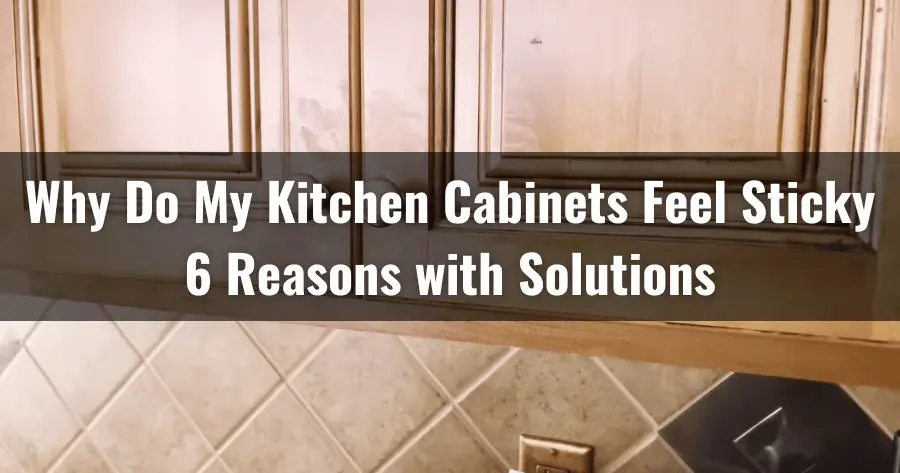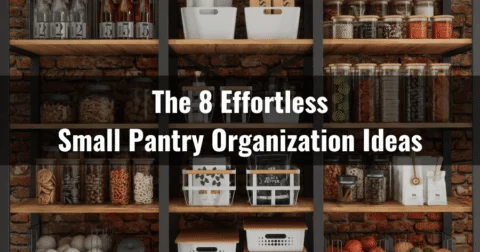Having sticky kitchen cabinets can be quite annoying when they collect dirt and grime and become tacky to the touch. It could be a more pleasant experience, and you may be wondering why this is happening.
One of the primary culprits behind sticky cabinets is improper cleaning techniques. Using the wrong cleaning products or leaving residue behind can cause a buildup that attracts more dirt over time. Also, excessive humidity in your kitchen can contribute to stickiness by causing moisture to accumulate on the cabinets.
Discover the baffling reasons behind your sticky kitchen cabinets and unlock powerful solutions to restore their sleekness.
Why Do My Kitchen Cabinets Feel Sticky: Top Reasons with Solutions

If your kitchen cabinets feel sticky, there could be a few reasons.
- Built-up grease and grime (oil residue)
- Excessive humidity in the kitchen
- Insects and pests
- Using the wrong cleaning products
- Cleaning with excessive vinegar
- Inadequate drying time
Built-up Grease and Grime (Oil Residue)
The buildup of grease and grime from cooking can cause this annoying stickiness, especially in areas directly above the stove or oven. Grease particles in the air settle onto cabinet surfaces, creating an oily residue that attracts dirt and dust.
To easily eliminate the sticky film on your kitchen cabinets, try using a degreaser or a vinegar and water solution. You can effectively eliminate this built-up grease and grime using a liquid degreaser.
A natural mixture of baking soda and water can also be used for more stubborn residue. Remember to scrub gently with a soft cloth to avoid damaging the cabinet finish.
Excessive Humidity in the Kitchen
High humidity in your kitchen can lead to excess moisture accumulation on your cabinets, creating a sticky surface. This can happen during hot summer or when cooking food that produces steam or vapor.
To prevent this, ensure your kitchen has adequate ventilation to escape moist air. Opening windows or using exhaust fans while cooking can help remove humid air from the space. Also, consider investing in a dehumidifier designed for kitchens to control excess moisture levels effectively.
Insects and Pests
Insects and pests can leave behind secretions that create an unappealing and sticky environment in your kitchen cabinets. Ants, roaches, and other unwanted critters often infiltrate our kitchens, seeking food sources and nesting areas.
These tiny intruders can contaminate your cabinets with their bodily fluids, which contain pheromones and other substances that attract more insects.
To eliminate this issue, remove these pests from your kitchen entirely. Ensure they cannot access your cabinets or food storage areas. Consider using an insecticide spray specifically designed for indoor use or consult with a pest control professional who can safely eradicate the infestation.
Using Wrong Cleaning Products
Using cleaning products that contain harsh chemicals can damage the finish of your cabinets and leave them with a sticky residue. These chemicals can strip away the protective layer on your cabinets and leave behind a sticky film that’s difficult to remove.
Avoid using cleaning products that contain bleach, ammonia, or silicones, as they can cause significant harm. Instead, use natural cleaning methods such as warm water and dish soap or vinegar.
These gentle cleaners will effectively clean your cabinets without causing any damage or leaving behind any stickiness. Always read the labels on cleaning products before using them to ensure they’re safe for use on your cabinets.
Cleaning with excessive Vinegar
Cleaning your cabinets with vinegar can be a game-changer, leaving them sparkling clean and free from sticky residue. However, when used excessively, vinegar can leave a light adhesive residue on your cabinets, making them feel sticky.
To avoid this issue, mix one vinegar with three warm water to clean lightly soiled areas regularly. In such cases, you can create a paste by mixing baking soda with water. Apply this paste onto the affected surfaces and let it sit for a few minutes before gently scrubbing it away using a soft cloth or sponge.
Inadequate Drying Time
Leaving cabinets damp after cleaning can result in a less than satisfactory outcome, hindering your kitchen’s overall cleanliness and appearance. When cabinets aren’t dried properly, moisture can be left behind, causing a sticky residue on the surface.
Always wipe your cabinets dry with a clean towel or cloth after cleaning them to prevent this issue. Also, allow them to air dry properly before replacing items or closing the cabinet doors.
What’s the Best Way to Clean Sticky Kitchen Cabinets?
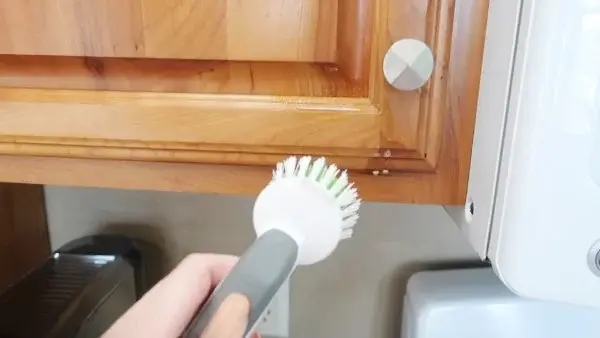
When cleaning kitchen cabinets, a 50/50 solution of vinegar and warm water is the go-to choice for professionals. This simple yet effective mixture can be easily made at home with a few basic ingredients.
Step 1: Gather Your Supplies
Before you start, gather all the supplies you need for the task. These include white vinegar, warm water, a spray bottle, a soft cloth, and liquid dishwashing detergent (optional).
Step 2: Mix Up the Solution
Mix equal vinegar and warm water in a spray bottle. If you are dealing with particularly stubborn grime or grease, add a few drops of liquid dishwashing detergent to the mixture.
Step 3: Spray and Wait
Spray the solution onto the cabinets, covering all the affected areas. Let the mixture sit on the surfaces for a minute or two to allow it to break down the grime and grease.
Step 4: Gently Wipe Down
Using a soft cloth, gently wipe down the cabinets, being careful not to damage the finish. Start from the top and work your way down, applying gentle pressure.
Step 5: Dry Thoroughly
Use a clean cloth to dry the cabinets thoroughly, ensuring no moisture is left behind. This will not only prevent further stickiness but also protect the cabinets from water damage in the long term.
FAQ’s
How Do You Fix Sticky Cabinets Naturally?
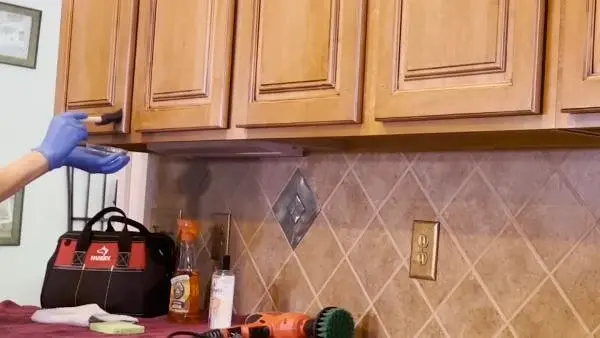
According to some real users, a simple homemade solution of baking soda, warm water, and lemon juice will effortlessly restore your cabinets to their smooth and gleaming state.
To fix sticky cabinets naturally, we recommended creating a cleaning solution by combining 1 part baking soda with 2 parts warm water and lemon juice. Once mixed, transfer the solution into a spray bottle for easy application.
Spray the liquid onto your sticky kitchen cabinets and let it sit for 2-3 minutes, allowing the baking soda to work its magic on the stickiness. Afterward, gently scrub away any grease or residue with a soft sponge.
Combining baking soda’s natural cleaning properties and lemon juice’s acidity will effectively break down the stickiness while leaving your cabinets fresh and clean.
What not to do after cleaning kitchen cabinets?
After cleaning your kitchen cabinets, avoid air drying them as it can potentially damage the finish and lead to bubbling. Instead, we recommend using a soft cloth to dry all damp surfaces and buff them to a shine. This will help prevent any stickiness that may occur after cleaning.
Also, refrain from using harsh or abrasive cleaners on your cabinets, as they can strip away the protective finish and leave them vulnerable to damage. Avoid using excessive water or moisture when cleaning, which can cause wood to warp or swell.
How many times should I clean kitchen cabinets?
Our research recommends regular maintenance and cleaning of your kitchen cabinets every 3 to 5 months to keep them in good condition. This will help prevent sticky residue from building up on the cabinet surfaces.
To maintain cleanliness, wipe away cooking residues, food smudges, and other stains from the cabinet surface or faces every week. Neglecting regular cleaning can cause a buildup of grime and dirt, making your cabinets feel sticky to the touch.
Can I use WD 40 on kitchen cabinets to remove the sticky residue?
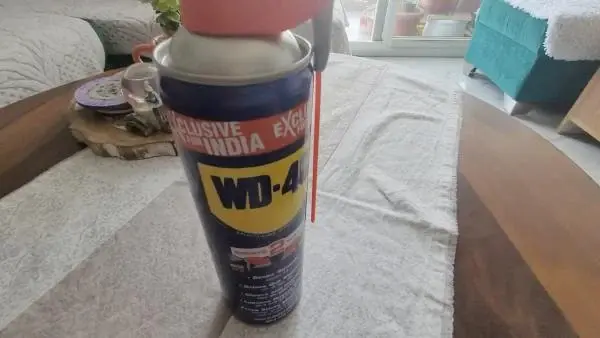
If you’re looking for a solution to keep your kitchen cabinets smooth and rust-free, WD-40 works great. When your cabinets start feeling sticky, it can be frustrating and unsightly. Sticky cabinets are usually caused by grease, grime, or even moisture buildup.
Fortunately, you can use WD-40 to solve this problem effectively. Its specially engineered formula lubricates and tackles rust while at it. Applying WD-40 to your sticky kitchen cabinets lets you easily remove the stickiness and restore their smoothness.
Simply spray a small amount onto a clean cloth and wipe down the affected areas. Remember to test it on an inconspicuous spot first to ensure compatibility with your cabinet material.
Conclusion
Several potential reasons exist if you’re wondering why your kitchen cabinets appear sticky. It could be due to a buildup of grease and grime, spills and splatters, or improper cleaning products.
To clean your cabinets effectively, consider hiring professionals with the knowledge and expertise to tackle this task. Vinegar or baking soda can help remove stickiness if you prefer a natural approach.
Remember to avoid certain cleaning practices that may damage your cabinets. Ultimately, regular cleaning is essential to maintain the cleanliness and longevity of your kitchen cabinets.


